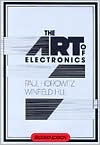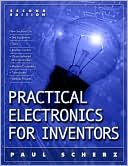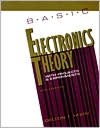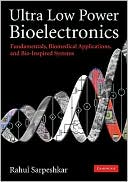Electromagnetics Explained
Based on familiar circuit theory and basic physics, this book serves as an invaluable reference for both analog and digital engineers alike. For those who work with analog RF, this book is a must-have resource. With computers and networking equipment of the 21st century running at such high frequencies, it is now crucial for digital designers to understand electromagnetic fields, radiation and transmission lines. This knowledge is necessary for maintaining signal integrity and achieving EMC...
Search in google:
Based on familiar circuit theory and basic physics, this book serves as an invaluable reference for both analog and digital engineers alike. For those who work with analog RF, this book is a must-have resource. With computers and networking equipment of the 21st century running at such high frequencies, it is now crucial for digital designers to understand electromagnetic fields, radiation and transmission lines. This knowledge is necessary for maintaining signal integrity and achieving EMC compliance. Since many digital designers are lacking in analog design skills, let alone electromagnetics, an easy-to-read but informative book on electromagnetic topics would be considered a welcome addition to their professional libraries. EDN Many engineers face a large gap between the elegant simplicity of Maxwell's equations and the practical aspects of electromagnetic issues. Electromagnetics Explained by Ron Schmitt bridges that chasm, starting with basics and fundamentals and then smoothly moving to electromagnetic fields; radiated waves; nonideal components; transmission lines; shielding; s-parameters; antennas; electromagnetic-compatibility issues; and advanced topics, such as lenses, dish and antenna arrays, diffraction, and frequency dependence of materials. It uses equations when necessary and also uses a straightforward, nonacademic style to provide readers with an intuitive grasp of the issues. The numerous drawings illuminate the points of the text, such as field patterns, current flows, and component models, and add to the readability of this book. Each chapter also has extensive references.
Introduction and Survey of the Electromagnetic Spectrum Fundamentals of Electric Fields Fundamentals of Magnetic Fields Electrodynamics, Radiation Relativity and Quantum Physics The Hidden Schematic Transmission Lines Waveguides Circuits as Waveguides S-Parameters Antennas: How to Make Circuits That Radiate, EMC and Layout: How to Make Circuits That Don't Radiate Part I: Basics Self-Compatibility and Signal Integrity Frequency Spectrum of Digital Signals Conducted versus Induced versus Radiated Interference Crosstalk Part II: PCB Techniques Circuit Layout PCB Transmission Lines The Path of Least Impedance The Fundamental Rule of Layout Shielding on PCBs Common Impedance: Ground Rise and Ground Bounce Distributed Grounds for High Frequency: The 5/5 Rule Tree or Hybrid Grounds Power Supply Decoupling: Problems and Techniques Power Supply Decoupling: The Design Process RF Decoupling Power Plane Ripples 90 Degree Turns and Chamfered Corners Layout of Transmission Line Terminations Routing of Signals: Ground Planes, Image Planes, and PCB Stackup 3W Rule for Preventing Crosstalk Layout Miscellany Layout Examples Star Grounds for Low Frequency Part III: Cabling Ground Loops (Multiple Return Paths) Differential Mode and Common Mode Radiation Cable Shielding Lenses and Antenna Arrays: RF Becomes Light, Diffraction: How Light Bends, Frequency Dependence of Materials
\ From the Publisher"The extensive background knowledge revealed in this book will help any EMC professional better understand, and better cope with, a diverse array of electromagnetic phenomena in modern computers". - Howard Johnson, author of "High-Speed Digital Design: A Handbook of Black Magic"\ Many engineers face a large gap between the elegant simplicity of Maxwell's equations and the practical aspects of electromagnetic issues. Electromagnetics Explained by Ron Schmitt bridges that chasm, starting with basics and fundamentals and then smoothly moving to electromagnetic fields; radiated waves; nonideal components; transmission lines; shielding; s-parameters; antennas; electromagnetic-compatibility issues; and advanced topics, such as lenses, dish and antenna arrays, diffraction, and frequency dependence of materials. - EDN\ It uses equations when necessary and also uses a straightforward, nonacademic style to provide readers with an intuitive grasp of the issues. The numerous drawings illuminate the points of the text, such as field patterns, current flows, and component models, and add to the readability of this book. Each chapter also has extensive references. - EDN\ The author pulled together a bunch of concepts in electromagnetics, and related them to real world problems. We found it a very refreshing (and useful) approach. Easy to read with lots of good stuff. - Kimmel & Gerke Associates' newsletter, EMI GURU\ Despite the hi-tech sound of the topics covered, this book contains very little math, and approaches its topics mostly from an intuitive point of view. The author obviously understands his subject very well, and considers his job to be making that subject as easy to understand as possible in a brief survey of the field. He does that job well.\ --Monitoring Times, March 2003\ Electromagnetics Explained presents a good blend of concepts and applications without requiring the user to work through advanced math.\ --E-Streams, Vol.6, No.6 - June 2003\ \ \ \ \ \ EMI GURU..."The author pulled together a bunch of concepts in electromagnetics, and related them to real world problems. We found it a very refreshing (and useful approach. Easy to read with lots of good stuff.\ \ \ EDNMany engineers face a large gap between the elegant simplicity of Maxwell's equations and the practical aspects of electromagnetic issues. Electromagnetics Explained by Ron Schmitt bridges that chasm, starting with basics and fundamentals and then smoothly moving to electromagnetic fields; radiated waves; nonideal components; transmission lines; shielding; s-parameters; antennas; electromagnetic-compatibility issues; and advanced topics, such as lenses, dish and antenna arrays, diffraction, and frequency dependence of materials. It uses equations when necessary and also uses a straightforward, nonacademic style to provide readers with an intuitive grasp of the issues. The numerous drawings illuminate the points of the text, such as field patterns, current flows, and component models, and add to the readability of this book. Each chapter also has extensive references.\ \








